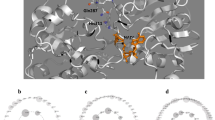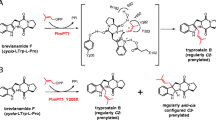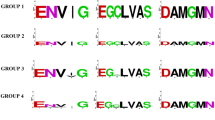Abstract
The α-aminoadipate reductase, a novel enzyme in the α-aminoadipic acid pathway for the biosynthesis of lysine in fungi, catalyzes the conversion of α-aminoadipic acid to α-aminoadipic-δ-semialdehyde in the presence of ATP, NADPH and MgCl2. This reaction requires two distinct gene products, Lys2p and Lys5p. In the presence of CoA, Lys5p posttranslationally activates Lys2p for the α-aminoadipate reductase activity. Sequence alignments indicate the presence of all functional domains required for the activation, adenylation, dehydrogenation and α-aminoadipic acid binding in the Lys2p. In this report we present the results of site-directed mutational analysis of the conserved amino acid residues in the catalytic domains of Lys2p from the pathogenic yeast Candida albicans. Mutants were generated in the LYS2 sequence of pCaLYS2SEI by PCR mutagenesis and expressed in E. coli BL21 cells. Recombinant mutants and the wild-type Lys2p were analyzed for their α-aminoadipate reductase activity. Substitution of threonine 416, glycine 418, serine 419, and lysine 424 of the adenylation domain (TXGSXXXXK, residues 416–424) resulted in a significant reduction in α-aminoadipate reductase activity compared to the unmutagenized Lys2p control. Similarly replacement of glycine 978, threonine 980, glycine 981, phenylalanine 982, leucine 983 and glycine 984 of the NADPH binding domain (GXTGFLG, residues 978–984) caused a drastic decrease in α-aminoadipate reductase activity. Finally, substitution of histidine 460, aspartic acid 461, proline 462, isoleucine 463, glutamine 464, arginine 465, and aspartic acid 466 of the putative α-aminoadipic acid binding domain (HDPIQRD, residues 460–466) resulted in a highly reduced α-aminoadipate reductase activity. These results confirm the hypothesis that specific amino acid residues in highly conserved catalytic domains of Lys2p are essential for the α-aminoadipate reductase activity.


Similar content being viewed by others
References
Affenzeller K, Jaklitsch WM, Honglinger C, Kubicek CP (1989) Lysine biosynthesis in Penicillium chrysogenum is regulated by feedback inhibition of alpha-aminoadipate reductase. FEMS Microbiol Lett 49:293–297
Barnes DA, Thorner J (1986) Genetic manipulation of Saccharomyces cerevisiae by use of the LYS2 gene. Mol Cell Biol 6:2828–2838
Bergendahl V, Linne U, Marahiel MA (2002) Mutational analysis of the C-domain in nonribosomal peptide synthesis. Eur J Biochem 269:620–629
Bhattacharjee JK (1985) α-Aminoadipate pathway for the synthesis of lysine in lower eukaryotes. CRC Crit Rev Microbiol 17:131–151
Bhattacharjee JK, Tucci AF (1969) Relationship of glutaric acid to the homocitric acid pathway of biosynthesis of lysine in yeast. J Biol Chem 244:1417–1423
Bhattacharjee JK, Suvarna K, Bhattacherjee V (2002) Reagents and kits for detecting fungal pathogens in biological samples. U.S. Patent No. 6,455,248 B1
Bhattacherjee V, Bhattacharjee JK (1999) Characterization of a double gene disruption in the Lys2 locus of the pathogenic yeast, Candida albicans. Med Mycol 37:411–417
Bleykasten-Grosshans C, Prior C, Potier S (2001) Cloning and sequence of the LYS2 homologue gene from the osmotolerant yeast Pichia sorbitophila. Yeast 18:61–67
Bodey GP (1988) The emergence of fungi as major hospital pathogens. J Hosp Infect 11:411–426
Bordo D, Argos P (1991) Suggestions for "safe" residue substitutions in site-directed mutagenesis. J Mol Biol 217:721–729
Broquist HP (1971) Lysine biosynthesis in yeast. Methods Enzymol 17B:112–129
Burik JH van, Magee PT (2001) Aspects of fungal pathogenesis in humans. Annu Rev Microbiol 55:743–772
Casqueiro J, Gutierrez S, Bonuelos O, Fierro F, Velasco J, Martin JF (1998) Characterization of the lys2 gene of Penicillium chrysogenum encoding α-aminoadipic acid reductase. Mol Gen Genet 259:549–556
Demain AL, Masurekar PS (1974) Lysine inhibition of the in vivo homocitrate synthase in Penicillium chrysogenum. J Gen Microbiol 82:143–151
Ehmann DE, Gehring AM, Walsh CT (1999) Lysine biosynthesis in Saccharomyces cerevisia: mechanism of α-aminoadipate reductase (Lys2) involves posttranslational phosphopantetheinylation by Lys5. Biochem 38:6171–6177
Eibel H, Phillippsen P (1983) Identification of the cloned S. cerevisiae LYS2 gene by an integrative transformation approach. Mol Gen Genet 191:66–73
Fonzi WA, Irwin MY (1993) Isogenic strain construction and gene mapping in Candida albicans. Genetics 134:717–728
Garrad R, Bhattacharjee JK (1992) Lysine biosynthesis in selected pathogenic fungi: characterization of lysine auxotrophs and the cloned LYS1 gene of Candida albicans.J Bacteriol 174:7379–7384
Garrad R, Schmidt TM, Bhattacharjee JK (1994) Molecular and functional analysis of the LYS1 gene of Candida albicans. Infect Immun 62:5027–5031
Gocht M, Marahiel MA (1994) Analysis of core sequences in the D-phe activating domain of the multifunctional peptide synthetase TycA by site-directed mutagenesis. J Bacteriol 176:2654–2662
Guo S, Evans SA, Wilkes MB, Bhattacharjee JK (2001) Novel posttranslational activation of the LYS2-encoded alpha-aminoadipate reductase for biosynthesis of lysine and site-directed mutational analysis of conserved amino acid residues in the activation domain of Candida albicans. J Bacteriol 183:7120–7125
Hijarrubia MJ, Aparicio JF, Casqueiro J, Martin JF (2001) Characterization of the lys2 gene of Acremonium chrysogenum encoding a functional α-aminoadipate activating and reducing enzyme. Mol Gen Genet 264:755–762
Miller KG, Bhattacharjee JK (1996) The LYS5 gene of S. cerevisiae. Gene 171:167–168
Morris ME, Jinks-Robertson S (1991) Nucleotide sequence of the LYS2 gene of S. cerevisiae, homology to Bacillus brevis tyrocidine synthase I. Gene 98:141–145
Perfect JR (1995) Molecular targets for new antifungal drugs. Can J Bot (Suppl 1):S1187–S1191
Sagisaka S, Shimura K (1962) Studies in lysine biosynthesis. IV. Mechanism of activation and reduction of α-aminoadipic acid (AAA). J Biochem 52:155–159
Sambrook J, Fritsch EF, Maniatis T (1989) Molecular cloning: a laboratory manual (2nd edn). Cold Spring Harbor Laboratory Press, Cold Spring Harbor, N.Y.
Sinha AK, Bhattacharjee JK (1970) Control of a lysine biosynthetic step by two unlinked genes of Saccharomyces. Biochem Biophys Res Commun 39:1205–1210
Sinha AK, Bhattacharjee JK (1971) Lysine biosynthesis in Saccharomyces, conversion of α-aminoadipate into α-aminoadipic δ-semialdehyde. Biochem J 125:743–749
Suvarna K, Seah L, Bhattacherjee V, Bhattacharjee JK (1998) Molecular analysis of the LYS2 gene: homology to antibiotic synthetases and the regulation of the α-aminoadipate reductase. Curr Genet 33:268–275
Umbarger HE (1987) Biosynthesis of the branched-chain amino acids. In: Neidhardt FC, Ingraham JL, Low KB, Magasanik B, Schaechter M, Umbarger HE (eds) Escherichia coli and Salmonella typhimurium: cellular and molecular biology. ASM Press, Washington, D.C., pp 352–367
Vogel HJ (1960) Distribution of lysine pathways among fungi: evolutionary implications. Am Nat 98:446–455
Acknowledgements
We thank, Dr. G. R. Janssen for reading the manuscript, Drs. G. Bhattacharjee and K. Suvarna for technical advice, Sondra Karipides for the synthesis of PCR primers, and Kathy Foster for typing the manuscript. Recombinant DNA experiments were performed in compliance with the guidelines of the Biosafety Committee of Miami University and the National Institutes of Health. This research was supported by NIGMS grant 1R15GM55912-0-1A1 to J. K. Bhattacharjee and the Ohio Board of Regents Academic Challenge Grant to the Microbiology Department
Author information
Authors and Affiliations
Corresponding author
Additional information
Communicated by C. A. M. J. J. van den Hondel
Rights and permissions
About this article
Cite this article
Guo, S., Bhattacharjee, J.K. Site-directed mutational analysis of the novel catalytic domains of α-aminoadipate reductase (Lys2p) from Candida albicans . Mol Gen Genomics 269, 271–279 (2003). https://doi.org/10.1007/s00438-003-0833-3
Received:
Accepted:
Published:
Issue Date:
DOI: https://doi.org/10.1007/s00438-003-0833-3




